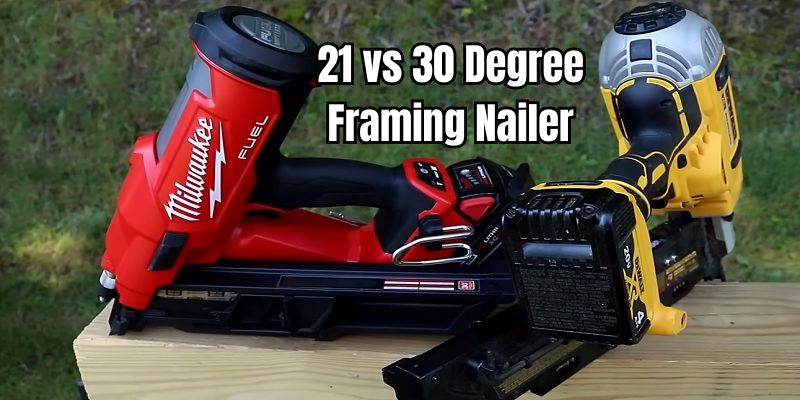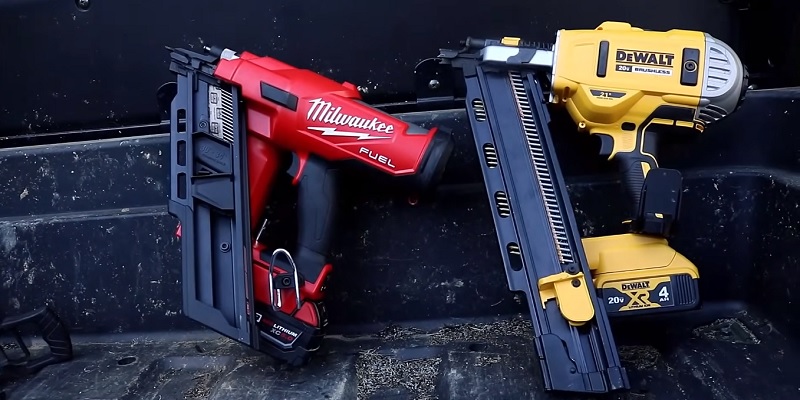When it comes to framing nailers, two popular options are the 21 degree and 30 degree models. While both are designed to drive nails into wood quickly and efficiently, they have distinct differences that make them better suited for specific applications.
In this article, we’ll take an in-depth look at the key factors that differentiate 21 and 30 degree framing nailers, helping you make an informed decision when selecting the right tool for your projects.

Understanding the Angle: 21 vs 30 Degrees
The primary difference between a 21 degree and 30 degree framing nailer lies in the angle of the nail magazine. A 21 degree framing nailer features a more compact design, with the magazine positioned at a 21-degree angle relative to the nosepiece. This allows for easier maneuverability in tight spaces and is particularly useful for applications that require precision, such as finishing work or working between studs.
On the other hand, a 30 degree framing nailer has a magazine angled at 30 degrees, providing a wider range of motion. This increased angle allows for greater versatility when nailing at steeper angles, such as when installing roof trusses or working on a pitched roof. The 30 degree design also offers improved access to hard-to-reach areas, making it a popular choice for framing and heavy-duty construction projects.
Nail Collation and Capacity
Another key difference between 21 and 30 degree framing nailers is the way the nails are collated and the capacity of the magazine. 21 degree framing nailers typically use plastic-collated nails, which are spaced farther apart. This results in a lower nail capacity per strip compared to 30 degree nailers. You may find yourself reloading more frequently with a 21 degree nailer, which can impact your overall productivity.
In contrast, 30 degree framing nailers often use paper-tape-collated nails, which are positioned more closely together. This allows for a higher nail capacity per strip, reducing the frequency of reloads. However, it’s important to note that paper collation can be more susceptible to moisture damage if exposed to wet conditions, so proper storage is essential.
Nail Head Type and Building Codes
When choosing between a 21 vs 30 degree framing nailer, it’s crucial to consider the type of nail head required for your project and local building codes. Traditionally, 30 degree framing nailers were associated with clipped-head or offset-head nails, which could pose issues with certain building codes in high-wind or seismic regions. These areas often require the use of full round-head nails to ensure structural integrity.

However, advancements in nail technology have led to the availability of 30 degree framing nails with full round heads, albeit with a slightly offset design. These nails are code-compliant in most regions, offering the benefits of a 30 degree nailer while meeting building requirements. On the other hand, 21 degree framing nailers have always been compatible with full round-head nails, making them a safe choice for projects subject to stringent building codes.
Weight and User Fatigue
The weight of the framing nailer is another factor to consider, especially if you’ll be using the tool for extended periods. A lighter nailer can reduce user fatigue and improve overall comfort during prolonged use. In general, 21 degree framing nailers tend to be slightly lighter than their 30 degree counterparts due to their more compact design.
However, the weight difference between the two types is often minimal, and the overall balance of the tool can play a more significant role in user comfort. It’s always a good idea to handle both types of nailers in person to gauge which one feels more comfortable and balanced in your hands.
Regional Preferences and Nail Availability
Interestingly, the preference for 21 degree vs 30 degree framing nailers varies by region. In the western United States, particularly in the Mountain West and West Coast regions, 21 degree nailers are more commonly used and readily available. This preference is rooted in historical building codes and the prevalent use of full round-head nails in these areas.
In contrast, the Midwest and Central regions of the United States tend to favor 30 degree framing nailers. The East Coast sees a more mixed bag, with both 21 and 30 degree nailers being used depending on the specific location and project requirements.
It’s essential to consider the availability of nails in your region when choosing a framing nailer. While both 21 and 30 degree nails are widely available, some regions may have a more limited selection of one type over the other. Ensure that you have a reliable source for the nails compatible with your chosen nailer to avoid any supply issues down the line.
Head to Head Comparison: 21 vs 30 Degree Framing Nailers
Here’s a quick comparison of the key factors to consider when choosing between a 21 and 30 degree framing nailer:
| Factor | 21 Degree Framing Nailer | 30 Degree Framing Nailer |
| Angle | 21 degrees | 30 degrees |
| Maneuverability | Excellent in tight spaces | Good overall versatility |
| Nail Collation | Plastic | Paper tape |
| Nail Capacity | Lower | Higher |
| Nail Head Type | Full round head | Full round head (offset) or clipped head |
| Weight | Slightly lighter | Slightly heavier |
| Regional Preference | Western US | Midwest, Central US, and mixed on East Coast |
Real-Life Examples: Choosing the Right Framing Nailer for the Job
To better understand when to use a 21 or 30 degree framing nailer, let’s look at some real-life examples:
1. Building a Deck: If you’re a homeowner building a deck, a 21 degree framing nailer might be the ideal choice. Its compact size and lightweight design make it easier to maneuver around the deck frame, driving nails into tight spaces and at various angles. The 21 degree angle of the nail magazine also allows for efficient nailing of the deck boards, ensuring a secure and stable finished product.
2. Framing a House: For a professional contractor tasking with framing a new house, a 30 degree framing nailer would likely be the better choice. The increased angle of the nail magazine allows for greater flexibility when nailing at steep angles, such as when attaching roof trusses or framing walls. The compatibility with longer nail sizes is also beneficial when working with thicker lumber or creating strong, load-bearing joints.
3. Remodeling a Room: When remodeling a room, such as removing old drywall, installing new insulation, and hanging new drywall panels, a 21 degree framing nailer could be the perfect tool. Its slim profile makes it easy to navigate between wall studs and drive nails into tight corners. The lightweight design also reduces fatigue during extended use, making the job more comfortable and efficient.
Whether you choose a 21 or 30 degree framing nailer for these tasks, you can find the best cordless options in our guide to the best cordless framing nailers, offering ultimate power and portability on your jobsite.

Making the Right Choice: Factors to Consider
When deciding between a 21 degree vs 30 degree framing nailer, keep these key factors in mind:
Project Type: Consider the types of projects you typically work on and their specific nailing requirements. Smaller, precision-oriented tasks may be better suited for a 21 degree nailer, while larger, more demanding projects may require the versatility of a 30 degree model.
Workspace Constraints: Think about the physical space in which you’ll be using the framing nailer. If you frequently work in tight quarters or need to maneuver around obstacles, a compact 21 degree nailer may be the better choice. On the other hand, if you have ample space to work and require a wider range of motion, a 30 degree nailer may be more appropriate.
Nail Size Requirements: Different projects may call for different nail sizes, so it’s important to choose a framing nailer that can accommodate the nails you’ll be using most often. While 21 degree nailers typically max out at 3-1/2 inches, 30 degree models can often handle nails up to 3-3/4 inches in length. Choosing the right nail size is crucial for a successful framing project. Discover the secrets to selecting the perfect size nails in our comprehensive guide on what size nail for framing?
User Comfort and Fatigue: Consider the weight and balance of the framing nailer, as well as the level of recoil and noise it produces. A lighter, more compact 21 degree nailer may be more comfortable to use for extended periods, while a heavier, more powerful 30 degree model may cause more fatigue and require more frequent breaks.
Budget and Value: Think about your budget and the overall value of the tool. While 21 degree framing nailers are often more affordable than their 30 degree counterparts, the added versatility and power of a 30 degree model may be worth the extra investment, depending on your needs.
Final Thoughts
In the end, the choice between a 21 vs 30 degree framing nailer comes down to your individual needs and preferences. By understanding the key differences between these two types of tools and considering the specific requirements of your projects, you can make an informed decision that will help you work more efficiently and effectively.
Whether you opt for the compact precision of a 21 degree nailer or the versatile power of a 30 degree model, investing in a high-quality framing nailer can make a world of difference in your work. Take the time to evaluate your options, weigh the pros and cons, and choose the tool that best fits your needs – your projects will thank you for it.


